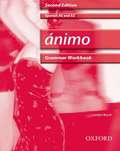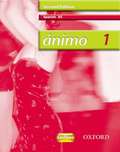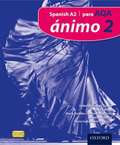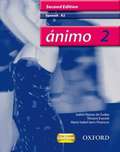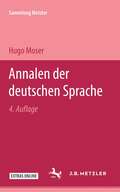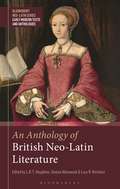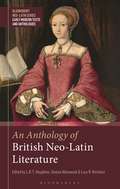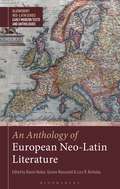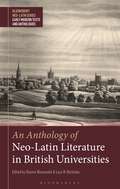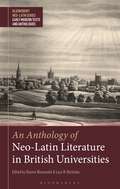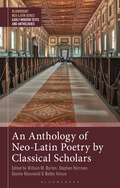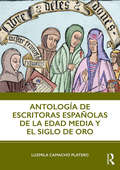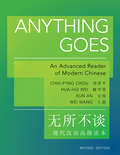- Table View
- List View
Animo: Spanish AS and A2 (PDF)
by Carolyn Burch'Animo' provides a smooth transition from GCSE to A Level, with a diagnostic test to determine students' abilities, clear grammatical explanations and full practice and language learning strategies.
Animo 1: Student Book (2nd edition) (PDF)
by Vivancos, Maria Isabel Isern Vincent Everett Alonso de Sudea, Isabel'Animo' provides a smooth transition from GCSE to A Level, with a diagnostic test to determine students' abilities, clear grammatical explanations and full practice and language learning strategies.
Animo 2: Spanish A2 Para AQA (PDF)
by Vincent Everett Isern Vivancos, Maria Isabel Alonso De SudeaThese editions are a complete match to the AQA specification, giving you everything you need for AQA A Level Spanish. It offers comprehensive grammar and skills support, helping students understand and manipulate new language.
Animo 2 Spanish A2: Student Book (2nd edition) (PDF)
by Alonso de Sudea, Isabel'Animo' provides a smooth transition from GCSE to A Level, with a diagnostic test to determine students' abilities, clear grammatical explanations and full practice and language learning strategies.
Annalen der deutschen Sprache von den Anfängen bis zur Gegenwart: Sammlung Metzler, 5 (Sammlung Metzler)
by Hugo MoserAn Anthology of British Neo-Latin Literature (Bloomsbury Neo-Latin Series: Early Modern Texts and Anthologies)
by Gesine Manuwald L. B. Houghton Lucy R. NicholasThis volume offers a wide range of sample passages from literature written in Latin in the British Isles during the period from about 1500 to 1800. It includes a general introduction to and bibliography to the Latin literature of these centuries, as well as Latin texts with English translations, introductions and notes. These texts present a rich panorama of the different literary genres, styles and themes flourishing at the time, illustrating the role of Latin texts in the development of literary genres, the diversity of authors writing in Latin in early modern Britain, and the importance of Latin in contemporary political, religious and scientific debates. The collection, which includes both texts by well-known authors (such as John Milton, Thomas More and George Buchanan) and previously unpublished items, can be used as a point of entry for students at school and university level, but will also be of interest to specialists in a number of academic disciplines.
An Anthology of British Neo-Latin Literature (Bloomsbury Neo-Latin Series: Early Modern Texts and Anthologies)
by Gesine Manuwald L. B. Houghton Lucy R. NicholasThis volume offers a wide range of sample passages from literature written in Latin in the British Isles during the period from about 1500 to 1800. It includes a general introduction to and bibliography to the Latin literature of these centuries, as well as Latin texts with English translations, introductions and notes. These texts present a rich panorama of the different literary genres, styles and themes flourishing at the time, illustrating the role of Latin texts in the development of literary genres, the diversity of authors writing in Latin in early modern Britain, and the importance of Latin in contemporary political, religious and scientific debates. The collection, which includes both texts by well-known authors (such as John Milton, Thomas More and George Buchanan) and previously unpublished items, can be used as a point of entry for students at school and university level, but will also be of interest to specialists in a number of academic disciplines.
An Anthology of European Neo-Latin Literature (Bloomsbury Neo-Latin Series: Early Modern Texts and Anthologies)
by Daniel Hadas, Gesine Manuwald and Lucy R. NicholasCompiled by a team of international experts, this volume showcases the best of the huge abundance of literature written in Latin in Europe from about 1500 to 1800. A general introduction provides readers with the context they need before diving into the 19 high-quality short Latin extracts and English translations. Together these texts present a rich panorama of the different literary genres, styles and themes that flourished at the time, and include authors such as Erasmus, Buchanan, Leibniz and Newton, along with less well-known writers.From the vast array of material available, a varied and meaningful sample of texts has been carefully curated by the editors of the volume. Passages not only exhibit literary merit or historical importance, but also illustrate the role of the complete texts from which they have been selected in the development of Neo-Latin literature. They reflect the wide range of authors writing in Latin in early modern Europe, as well as the importance of Latin in the history of ideas.As with all volumes in the series, section introductions and accompanying notes on every text provide orientation on the material for students.
An Anthology of European Neo-Latin Literature (Bloomsbury Neo-Latin Series: Early Modern Texts and Anthologies)
Compiled by a team of international experts, this volume showcases the best of the huge abundance of literature written in Latin in Europe from about 1500 to 1800. A general introduction provides readers with the context they need before diving into the 19 high-quality short Latin extracts and English translations. Together these texts present a rich panorama of the different literary genres, styles and themes that flourished at the time, and include authors such as Erasmus, Buchanan, Leibniz and Newton, along with less well-known writers.From the vast array of material available, a varied and meaningful sample of texts has been carefully curated by the editors of the volume. Passages not only exhibit literary merit or historical importance, but also illustrate the role of the complete texts from which they have been selected in the development of Neo-Latin literature. They reflect the wide range of authors writing in Latin in early modern Europe, as well as the importance of Latin in the history of ideas.As with all volumes in the series, section introductions and accompanying notes on every text provide orientation on the material for students.
An Anthology of Neo-Latin Literature in British Universities (Bloomsbury Neo-Latin Series: Early Modern Texts and Anthologies)
by Gesine Manuwald and Lucy R. NicholasCompiled by a team of experts in the field, this volume brings to view an array of Latin texts produced in British universities from c.1500 to 1700. It includes a comprehensive introduction to the production of Neo-Latin and Neo-Greek in the early modern university, the precise circumstances and broader environments that gave rise to it, plus an associated bibliography. 12 high-quality sections, each prefaced by its own short introduction, set forth the Latin (and occasionally Greek) texts and accompanying English translations and notes. Each section provides focused orientation and is arranged in such a way as to ensure the volume's accessibility to scholars and students at all levels of familiarity with Neo-Latin. Passages are taken from documents that were composed in seats of learning across the British Isles, in Oxford, Cambridge, Dublin, Edinburgh and St Andrews, and adduce a wide range of material from orations and disputational theses to collections of occasional verse, correspondence, notebooks and university drama. This anthology as a whole conveys a sense of the extent of Latin's role in the academy and the span of remits in which it was deployed. Far from simply offering a snapshot of discrete projects, the contributions collectively offer insights into the broader culture of the early modern university over an extended period. They engage with the administrative operations of institutions, pedagogical processes and academic approaches, but also high-level disputes and the universities' relationship with the worlds of politics, new science and intellectual developments elsewhere in Europe.
An Anthology of Neo-Latin Literature in British Universities (Bloomsbury Neo-Latin Series: Early Modern Texts and Anthologies)
Compiled by a team of experts in the field, this volume brings to view an array of Latin texts produced in British universities from c.1500 to 1700. It includes a comprehensive introduction to the production of Neo-Latin and Neo-Greek in the early modern university, the precise circumstances and broader environments that gave rise to it, plus an associated bibliography. 12 high-quality sections, each prefaced by its own short introduction, set forth the Latin (and occasionally Greek) texts and accompanying English translations and notes. Each section provides focused orientation and is arranged in such a way as to ensure the volume's accessibility to scholars and students at all levels of familiarity with Neo-Latin. Passages are taken from documents that were composed in seats of learning across the British Isles, in Oxford, Cambridge, Dublin, Edinburgh and St Andrews, and adduce a wide range of material from orations and disputational theses to collections of occasional verse, correspondence, notebooks and university drama. This anthology as a whole conveys a sense of the extent of Latin's role in the academy and the span of remits in which it was deployed. Far from simply offering a snapshot of discrete projects, the contributions collectively offer insights into the broader culture of the early modern university over an extended period. They engage with the administrative operations of institutions, pedagogical processes and academic approaches, but also high-level disputes and the universities' relationship with the worlds of politics, new science and intellectual developments elsewhere in Europe.
An Anthology of Neo-Latin Poetry by Classical Scholars (Bloomsbury Neo-Latin Series: Early Modern Texts and Anthologies)
by William M. Barton, Stephen Harrison, Gesine Manuwald and Bobby XinyuePresenting a range of Neo-Latin poems written by distinguished classical scholars across Europe from c. 1490 to c. 1900, this anthology includes a selection of celebrated names in the history of scholarship. Individual chapters present the Neo-Latin poems alongside new English translations (usually the first) and accompanying introductions and commentaries that annotate these verses for a modern readership, and contextualise them within the careers of their authors and the history of classical scholarship in the Renaissance and early modern period.An appealing feature of Renaissance and early modern Latinity is the composition of fine Neo-Latin poetry by major classical scholars, and the interface between this creative work and their scholarly research. In some cases, the two are actually combined in the same work. In others, the creative composition and scholarship accompany each other along parallel tracks, when scholars are moved to write their own verse in the style of the subjects of their academic endeavours. In still further cases, early modern scholars produced fine Latin verse as a result of the act of translation, as they attempted to render ancient Greek poetry in a fitting poetic form for their contemporary readers of Latin.
An Anthology of Neo-Latin Poetry by Classical Scholars (Bloomsbury Neo-Latin Series: Early Modern Texts and Anthologies)
Presenting a range of Neo-Latin poems written by distinguished classical scholars across Europe from c. 1490 to c. 1900, this anthology includes a selection of celebrated names in the history of scholarship. Individual chapters present the Neo-Latin poems alongside new English translations (usually the first) and accompanying introductions and commentaries that annotate these verses for a modern readership, and contextualise them within the careers of their authors and the history of classical scholarship in the Renaissance and early modern period.An appealing feature of Renaissance and early modern Latinity is the composition of fine Neo-Latin poetry by major classical scholars, and the interface between this creative work and their scholarly research. In some cases, the two are actually combined in the same work. In others, the creative composition and scholarship accompany each other along parallel tracks, when scholars are moved to write their own verse in the style of the subjects of their academic endeavours. In still further cases, early modern scholars produced fine Latin verse as a result of the act of translation, as they attempted to render ancient Greek poetry in a fitting poetic form for their contemporary readers of Latin.
Anti-contiguity: A Theory of Wh- Prosody (Oxford Studies in Comparative Syntax)
by Jason KandybowiczA recent wave of research has explored the link between wh- syntax and prosody, breaking with the traditional generative conception of a unidirectional syntax-phonology relationship. In this book, Jason Kandybowicz develops Anti-contiguity Theory as a compelling alternative to Richards' Contiguity Theory to explain the interaction between the distribution of interrogative expressions and the prosodic system of a language. Through original and highly detailed fieldwork on several under-studied West African languages (Krachi, Bono, Wasa, Asante Twi, and Nupe), Kandybowicz presents empirically and theoretically rich analyses bearing directly on a number of important theories of the syntax-prosody interface. His observations and analyses stem from original fieldwork on all five languages and represent some of the first prosodic descriptions of the languages. The book also considers data from thirteen additional typologically diverse languages to demonstrate the theory's reach and extendibility. Against the backdrop of data from eighteen languages, Anti-contiguity offers a new lens on the empirical and theoretical study of wh- prosody.
ANTI-CONTIGUITY OSCS C: A Theory of Wh- Prosody (Oxford Studies in Comparative Syntax)
by Jason KandybowiczA recent wave of research has explored the link between wh- syntax and prosody, breaking with the traditional generative conception of a unidirectional syntax-phonology relationship. In this book, Jason Kandybowicz develops Anti-contiguity Theory as a compelling alternative to Richards' Contiguity Theory to explain the interaction between the distribution of interrogative expressions and the prosodic system of a language. Through original and highly detailed fieldwork on several under-studied West African languages (Krachi, Bono, Wasa, Asante Twi, and Nupe), Kandybowicz presents empirically and theoretically rich analyses bearing directly on a number of important theories of the syntax-prosody interface. His observations and analyses stem from original fieldwork on all five languages and represent some of the first prosodic descriptions of the languages. The book also considers data from thirteen additional typologically diverse languages to demonstrate the theory's reach and extendibility. Against the backdrop of data from eighteen languages, Anti-contiguity offers a new lens on the empirical and theoretical study of wh- prosody.
'Anticipating' the 2011 Arab Uprisings: Revolutionary Literatures and Political Geographies
by R. SakrThis Palgrave Pivot volume explores an exciting range of powerful novels and memoirs from Tunisia, Egypt, Libya, and Syria that reveal political geographies of injustice and popular discontent thus 'anticipating' or imaginatively envisioning as well as participating in some of the major current upheavals in their particular national contexts.
The Antiracist World Language Classroom
by Krishauna Hines-Gaither Cécile AccilienHow can you incorporate antiracist practices into specific subject areas? This essential book finally answers that question and offers a clear roadmap for introducing antiracism into the world language classroom. Drawing on foundational and cutting-edge knowledge of antiracism, authors Hines-Gaither and Accilien address the following questions: what does antiracism look like in the world language classroom; why is it vital to implement antiracist practices relevant to your classroom or school; and how can you enact antiracist pedagogies and practices that enrich and benefit your classroom or school? Aligned with the American Council on the Teaching of Foreign Languages standards, the book is filled with hands-on antiracist activities, strategies, and lesson plans. The book covers all necessary topics, including designing antiracist units of study, teaching across proficiency levels, advocacy and collaboration in the community, and how to facilitate self- reflection to become an active antiracist educator. The tools, prompts, and resources in this book are essential for any world language teacher, department chair, or school leader.
The Antiracist World Language Classroom
by Krishauna Hines-Gaither Cécile AccilienHow can you incorporate antiracist practices into specific subject areas? This essential book finally answers that question and offers a clear roadmap for introducing antiracism into the world language classroom. Drawing on foundational and cutting-edge knowledge of antiracism, authors Hines-Gaither and Accilien address the following questions: what does antiracism look like in the world language classroom; why is it vital to implement antiracist practices relevant to your classroom or school; and how can you enact antiracist pedagogies and practices that enrich and benefit your classroom or school? Aligned with the American Council on the Teaching of Foreign Languages standards, the book is filled with hands-on antiracist activities, strategies, and lesson plans. The book covers all necessary topics, including designing antiracist units of study, teaching across proficiency levels, advocacy and collaboration in the community, and how to facilitate self- reflection to become an active antiracist educator. The tools, prompts, and resources in this book are essential for any world language teacher, department chair, or school leader.
Antología de escritoras españolas de la Edad Media y el Siglo de Oro
by Luzmila Camacho Platero; Javier Muñoz-BasolsAntología de escritoras españolas de la Edad Media y el Siglo de Oro ofrece una selección de obras literarias de ocho escritoras medievales, renacentistas y barrocas. Cada capítulo presenta una extensa introducción sobre la autora y su obra. Esta antología contribuye a mejorar el conocimiento de los estudiantes sobre la lengua, la literatura y la cultura españolas, al igual que ofrece una lectura desde la perspectiva de género de estas escritoras. Acompañada de textos originales modernizados al castellano actual, notas aclaratorias, actividades y una extensa y actualizada bibliografía, Antología de escritoras españolas de la Edad Media y el Siglo de Oro muestra la evolución de voces femeninas a lo largo de estos siglos. Las actividades sugeridas para cada capítulo ayudan a exponer y a reflexionar sobre la relevancia cultural que en la actualidad tienen los argumentos que estas mujeres proponent en sus trabajos. Esta antología será de gran utilidad para estudiantes de literatura y cultura españolas de niveles de grado y graduado e, igualmente, para los estudiantes hispanohablantes de literature comparada y de estudios de género.
Antología de escritoras españolas de la Edad Media y el Siglo de Oro
by Luzmila Camacho PlateroAntología de escritoras españolas de la Edad Media y el Siglo de Oro ofrece una selección de obras literarias de ocho escritoras medievales, renacentistas y barrocas. Cada capítulo presenta una extensa introducción sobre la autora y su obra. Esta antología contribuye a mejorar el conocimiento de los estudiantes sobre la lengua, la literatura y la cultura españolas, al igual que ofrece una lectura desde la perspectiva de género de estas escritoras. Acompañada de textos originales modernizados al castellano actual, notas aclaratorias, actividades y una extensa y actualizada bibliografía, Antología de escritoras españolas de la Edad Media y el Siglo de Oro muestra la evolución de voces femeninas a lo largo de estos siglos. Las actividades sugeridas para cada capítulo ayudan a exponer y a reflexionar sobre la relevancia cultural que en la actualidad tienen los argumentos que estas mujeres proponent en sus trabajos. Esta antología será de gran utilidad para estudiantes de literatura y cultura españolas de niveles de grado y graduado e, igualmente, para los estudiantes hispanohablantes de literature comparada y de estudios de género.
Anything Goes: An Advanced Reader of Modern Chinese (PDF)
by Chih-P'Ing Chou Hua-Hui Wei Kun An Wei WangSuitable for students with three or more years of modern Chinese language instruction, Anything Goes uses advanced materials to reinforce language skills and increase understanding of contemporary China in one semester. This fully revised edition provides learners with a deeper fluency in high-level Chinese vocabulary and grammar, and includes newspaper articles and critiques as well as other primary source documents, such as political speeches and legal documents. The textbook covers topics that are essential to understanding contemporary Chinese society, including changing attitudes toward women and marriage, the one-child policy, economic development, China's ethnic minorities, and debates surrounding Taiwan and Hong Kong. The lessons intentionally investigate thought-provoking and sometimes controversial issues in order to spark lively classroom discussions. This new edition incorporates suggestions and improvements from years of student and teacher feedback. With an improved, more user-friendly format, Anything Goes juxtaposes text and vocabulary on adjacent pages. Grammar explanations and exercises have also been thoroughly updated. Advanced-level Chinese language textbook Includes newspaper articles and primary source documents Thought-provoking topics on contemporary Chinese society Updated grammar explanations and exercises New user-friendly format
Applied Linguistics in the Indonesian Context: Society, Culture and Language (Engaging Indonesia)
by Richmond Stroupe Lilie RoosmanThis open access edited volume presents a series of studies utilizing a variety of linguistic research techniques to investigate areas of language education, acquisition and assessment, contemporary political debate, modern and historical print media, and clinical language disorders, in the Indonesian context. In doing so, the authors provide a rich and diverse overview of current research in the fields of linguistics and applied linguistics. The initial section focuses on research conducted in educational settings, focusing on English-medium instruction (EMI), reading assessment, discovery-based learning, cultural elements in textbooks, and pre-service teacher preparation in Indonesia, offering recommendations for improving language education. The second section demonstrates the applications of corpus linguistics, focusing on collocation patterns in different languages, lexical use and context of rhetorical markers, and authorship determination. A third section presents investigations related to aspects of historical and contemporary language use in a variety of contexts, including advertisements, political debate, Indonesian print media, and translanguaging and multilingual writings, discussing the social and cultural dimensions of language use in Indonesia. The final section focuses on clinical linguistics, investigating the relationship between language disorders and language use, including spoken narratives provided by patients with Alzheimer's and the structure and time reference use of agrammatic speakers, with valuable insights into the understanding, diagnosis and treatment of language disorders. Brought together in a single volume, the chapters illustrate how linguistic analysis can be applied across a variety of disciplines and research sites. The volume is relevant to linguists, educators, sociologists, historians, and members of the medical community with particular interest in the Indonesian context.
Applying Anzalduan Frameworks to Understand Transnational Youth Identities: Bridging Culture, Language, and Schooling at the US-Mexican Border (Routledge Research in Educational Equality and Diversity)
by G. Sue Kasun Irasema Mora-PabloFramed by the theoretical work of Gloria Anzaldúa, this volume focuses on the cultural and linguistic practices of Mexican-origin youth at the U.S. border to explore how young people engage in acts of "bridging" to develop rich, transnational identities. Using a wealth of empirical data gathered through interviews and observations, and featuring perspectives from multinational and transnational authors, this text highlights how youth resist racialized and raciolinguistic oppression in both formal and informal contexts by purposefully engaging with their heritage culture and language. In doing so, they defy deficit narratives and negotiate identities in the "in-between." As a whole, the volume engages issues of identity, language, and education, and offers a uniquely asset-based perspective on the complexities of transnational youth identity, demonstrating its value in educational and academic spaces in particular. This text will benefit researchers, academics, and educators with an interest in the sociology of education, multicultural education, and youth culture more broadly. Those interested in language and identity studies, as well as adolescence, schooling, and bilingualism, will also benefit from this volume.
Applying Anzalduan Frameworks to Understand Transnational Youth Identities: Bridging Culture, Language, and Schooling at the US-Mexican Border (Routledge Research in Educational Equality and Diversity)
by G. Sue Kasun Irasema Mora-PabloFramed by the theoretical work of Gloria Anzaldúa, this volume focuses on the cultural and linguistic practices of Mexican-origin youth at the U.S. border to explore how young people engage in acts of "bridging" to develop rich, transnational identities. Using a wealth of empirical data gathered through interviews and observations, and featuring perspectives from multinational and transnational authors, this text highlights how youth resist racialized and raciolinguistic oppression in both formal and informal contexts by purposefully engaging with their heritage culture and language. In doing so, they defy deficit narratives and negotiate identities in the "in-between." As a whole, the volume engages issues of identity, language, and education, and offers a uniquely asset-based perspective on the complexities of transnational youth identity, demonstrating its value in educational and academic spaces in particular. This text will benefit researchers, academics, and educators with an interest in the sociology of education, multicultural education, and youth culture more broadly. Those interested in language and identity studies, as well as adolescence, schooling, and bilingualism, will also benefit from this volume.
Applying Linguistics in the Classroom: A Sociocultural Approach
by Aria Razfar Joseph C. RumenappMaking linguistics accessible and relevant to all teachers, this text looks at language issues in the classroom through an applied sociocultural perspective focused on how language functions in society and in schools—how it is used, for what purposes, and how teachers can understand their students’ language practices. While touching on the key structural aspects of language (phonetics, phonology, morphology, and syntax), it does not simply give an overview, but rather provides a way to study and talk about language. Each chapter includes practical steps and suggests tools for applying different kinds of linguistic knowledge in classrooms. The activities and exercises are adaptable to elementary or high school settings. Many examples focus on the intersection of math, science, and language. Teacher case studies show how real teachers have used these concepts to inform teaching practices. Given the increasing use of multimedia resources in today’s schools, multiple mediums are integrated to engage educators in learning about language. The Companion Website provides a multitude of relevant resources that illustrate the diversity of language functions and debates about language in society.
